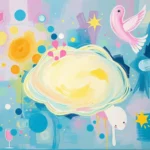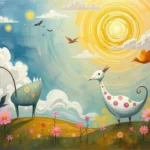
Dreams have fascinated humanity for centuries, serving as a window into our subconscious and a reflection of our innermost thoughts, fears, and desires. In many cultures, particularly in ancient China, dreams were seen as significant messages from the divine or the universe. The interpretation of dreams was not merely a pastime; it was an essential aspect of understanding one’s fate and destiny. Ancient Chinese dream symbolism offers rich insights into the spiritual and emotional landscapes of dreamers, providing a unique lens through which to explore our waking lives.
Understanding the symbolism behind our dreams is relevant today, as it can help illuminate our thoughts, emotions, and life circumstances. The allure of dream analysis lies in its ability to connect us with deeper meanings, reflecting our life experiences and guiding us toward self-awareness. This article delves into the fascinating realm of ancient Chinese dream symbolism, exploring its meanings, variations, and how it can resonate with our real-life situations.
Symbolism and Meaning
In ancient Chinese culture, dreams were thought to carry significant meanings, often linked to the dreamer’s health, relationships, and spiritual state. Various symbols commonly appeared in dreams, each with its own interpretation. For instance, water often represented emotions and the unconscious mind. Dreaming of calm water could signify peace and tranquility, while turbulent water might indicate emotional turmoil or challenges ahead.
Another prevalent symbol was dragons, revered in Chinese mythology as powerful and auspicious creatures. A dream featuring a dragon could symbolize strength, ambition, and potential. However, if the dragon appeared menacing, it could reflect feelings of being overwhelmed or threatened by circumstances in waking life.
Birds also held significant symbolism in ancient Chinese dreams. Generally, they are seen as messengers of change or transformation. A dream of soaring birds might signify freedom and aspiration, while a dream of caged birds could represent feelings of confinement or restriction in one’s waking life.
Colors played a crucial role in dream interpretation as well. For example, the color red often symbolized good fortune and happiness, while black might indicate danger or the unknown. When analyzing dreams, the emotional tone associated with these colors can provide further insight into the dreamer’s mental state.
While these symbols hold general meanings, it’s important to remember that personal context can significantly influence their interpretation. Each individual’s life experiences, emotions, and current circumstances will color their understanding of these dream symbols. Thus, reflection on personal feelings tied to the symbols is essential for a deeper interpretation.
Key Scenarios and Variations
Dreams can take on various forms and scenarios, which can drastically alter their interpretations. For example, consider the scenario of flying. In ancient Chinese culture, flying often symbolizes liberation and transcendence, suggesting the dreamer is breaking free from restrictions. However, if the dreamer feels fear while flying, it may indicate anxieties about taking risks or facing the unknown.
Another common scenario is being chased. This type of dream often reflects feelings of anxiety or avoidance in waking life. In ancient Chinese symbolism, being chased might indicate a need to confront certain fears or unresolved issues. The identity of the pursuer can also change the dream’s meaning; for instance, if it represents a family member, it might symbolize familial pressures or dynamics that require attention.
Falling is another scenario with significant implications. In many cultures, including ancient China, falling in a dream can represent a loss of control or fear of failure. However, it can also signify a necessary release from burdens or an invitation to embrace vulnerability.
The act of visiting a deceased loved one in a dream holds profound emotional significance. In ancient Chinese beliefs, such dreams are often viewed as a connection to the spiritual realm, offering comfort or closure. The manner in which the loved one appears—whether joyful or distressed—can provide insight into the dreamer’s emotional state regarding their loss and unresolved feelings.
Each scenario allows for a range of interpretations, emphasizing the importance of context and personal experience. Reflecting on the emotions felt during these dreams can guide the dreamer toward understanding their implications and what they might reveal about their waking life.
Real-Life Connections and Takeaways
Translating dream symbolism into real-life insights can be a transformative experience. Readers are encouraged to reflect on their own dreams and consider how the symbols and scenarios resonate with their current life situations. For instance, if you have recently experienced a dream involving water, think about your emotional state. Are you feeling calm and at peace, or are you navigating turbulent waters emotionally? This reflection can foster self-awareness and prompt necessary changes in your life.
When analyzing dreams featuring dragons, consider your ambitions and aspirations. Are there areas in your life where you feel empowered and capable? Alternatively, if the dragon appears threatening, it may indicate that certain challenges need addressing or that you feel overwhelmed by circumstances beyond your control.
The symbolism of birds can also provide valuable insights. If you dream of soaring birds, contemplate what changes or transformations you are currently experiencing or seeking in your life. On the other hand, if you dream of caged birds, it may be time to evaluate any restrictions or limitations that you feel are holding you back.
The emotions and situations surrounding the key scenarios of flying, being chased, or falling can serve as mirrors reflecting your internal struggles and aspirations. These dreams can guide you to confront fears, embrace change, or relinquish control in certain areas of your life.
A practical approach to self-reflection can involve keeping a dream journal. Documenting your dreams and noting the symbols, emotions, and scenarios can help you draw connections to your waking life over time. This practice fosters a deeper understanding of your subconscious and can illuminate patterns that influence your behavior and choices.
In essence, ancient Chinese dream symbolism invites us to explore the depths of our psyche, encouraging personal growth and self-discovery. By reflecting on our dreams and their meanings, we unlock the door to deeper understanding and can navigate our lives with greater clarity and purpose.
In conclusion, ancient Chinese dream symbolism serves as a profound tool for introspection and self-exploration. The rich tapestry of symbols and scenarios offers insights that can resonate with our emotions, aspirations, and challenges. As you engage with your dreams, remember to approach them with an open mind and a willingness to reflect on their meanings in the context of your life. Embrace the journey of self-discovery that dreams can provide, and allow their wisdom to guide you toward a deeper understanding of yourself and your path forward.







